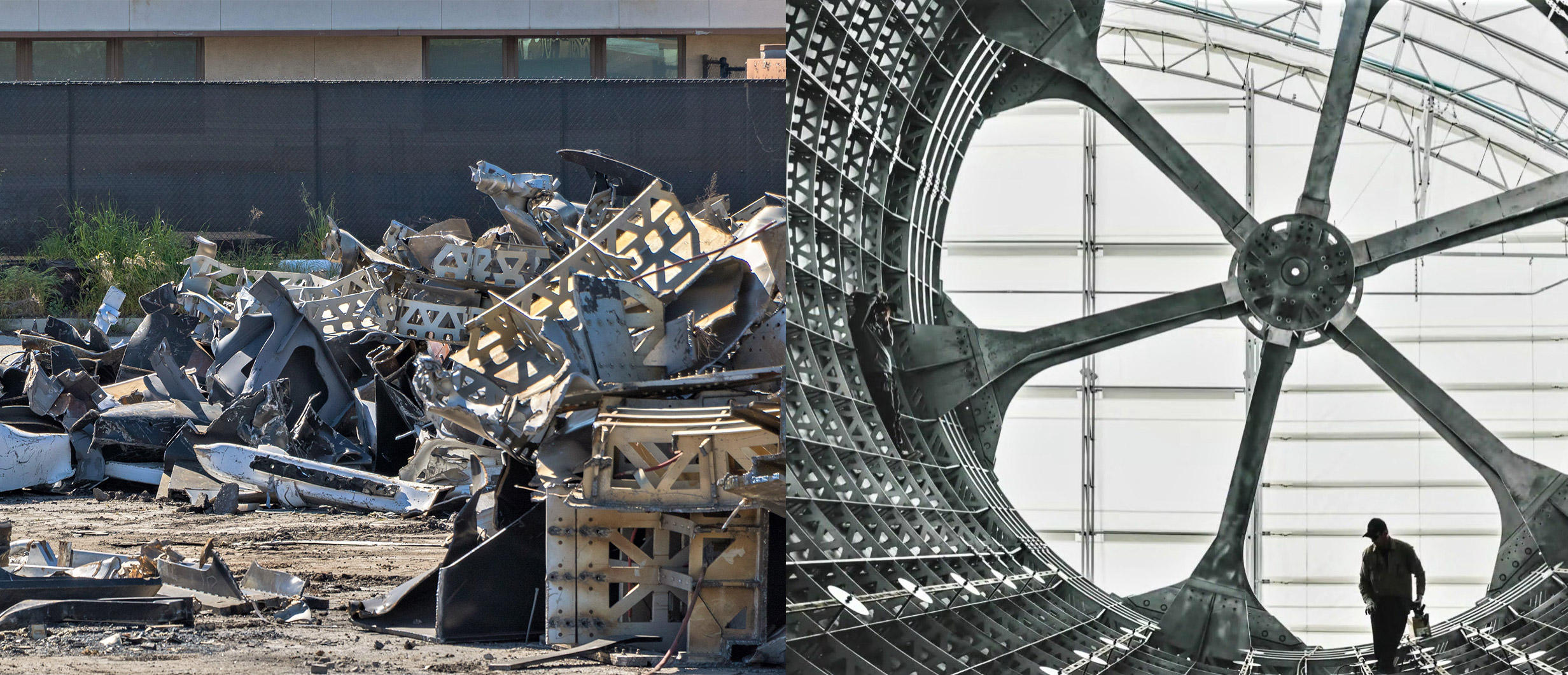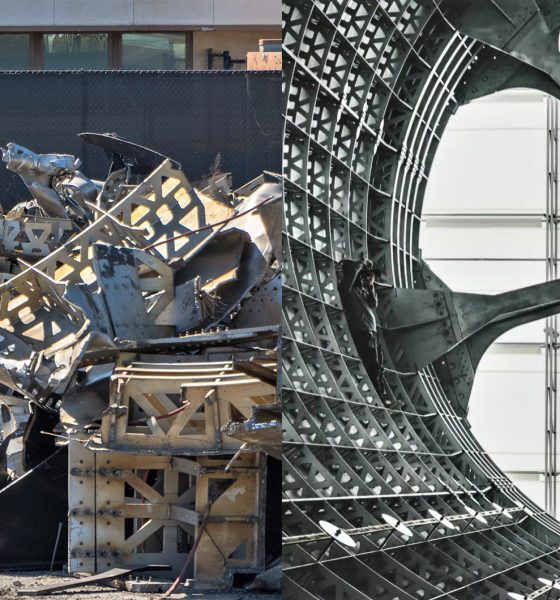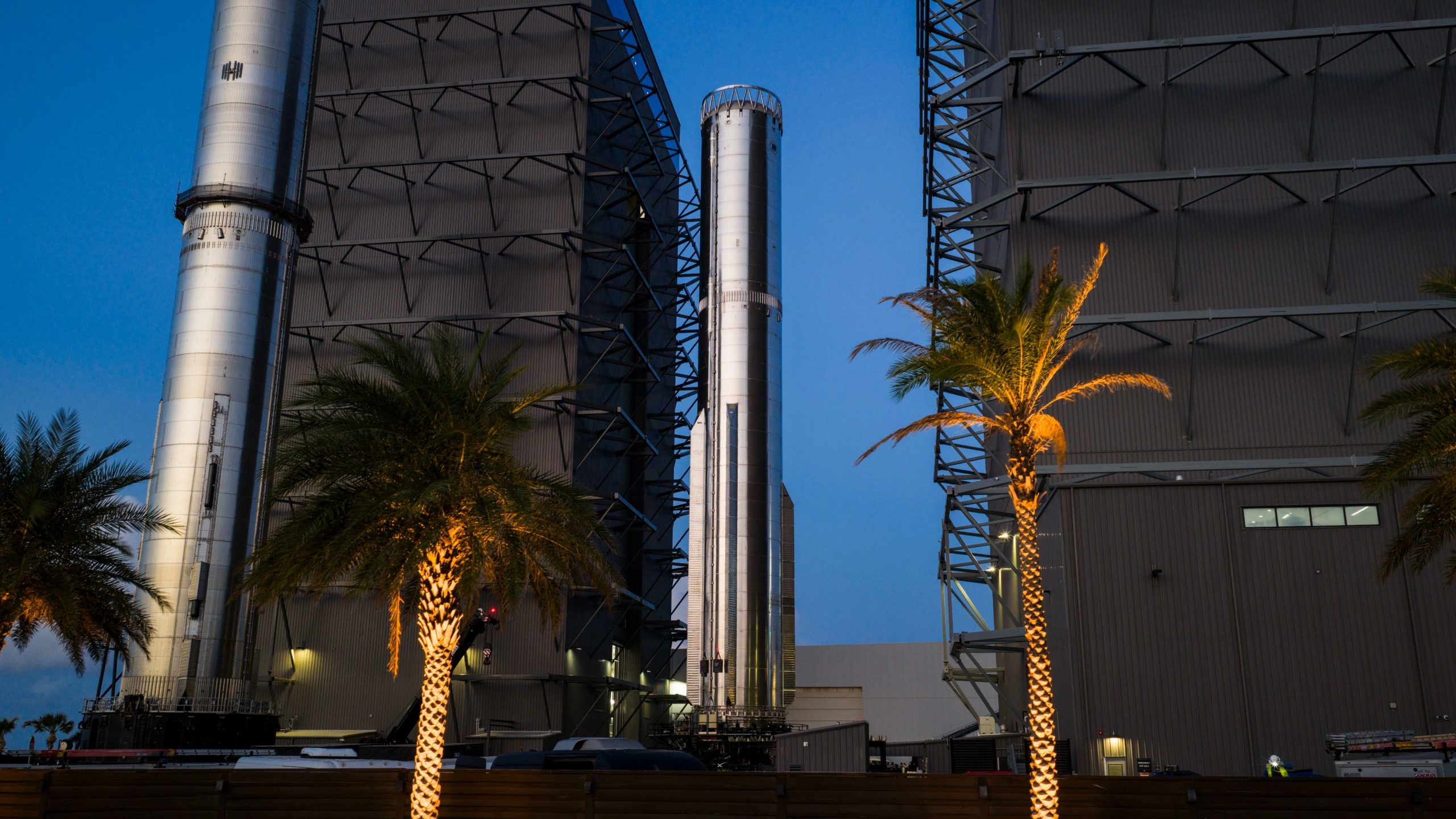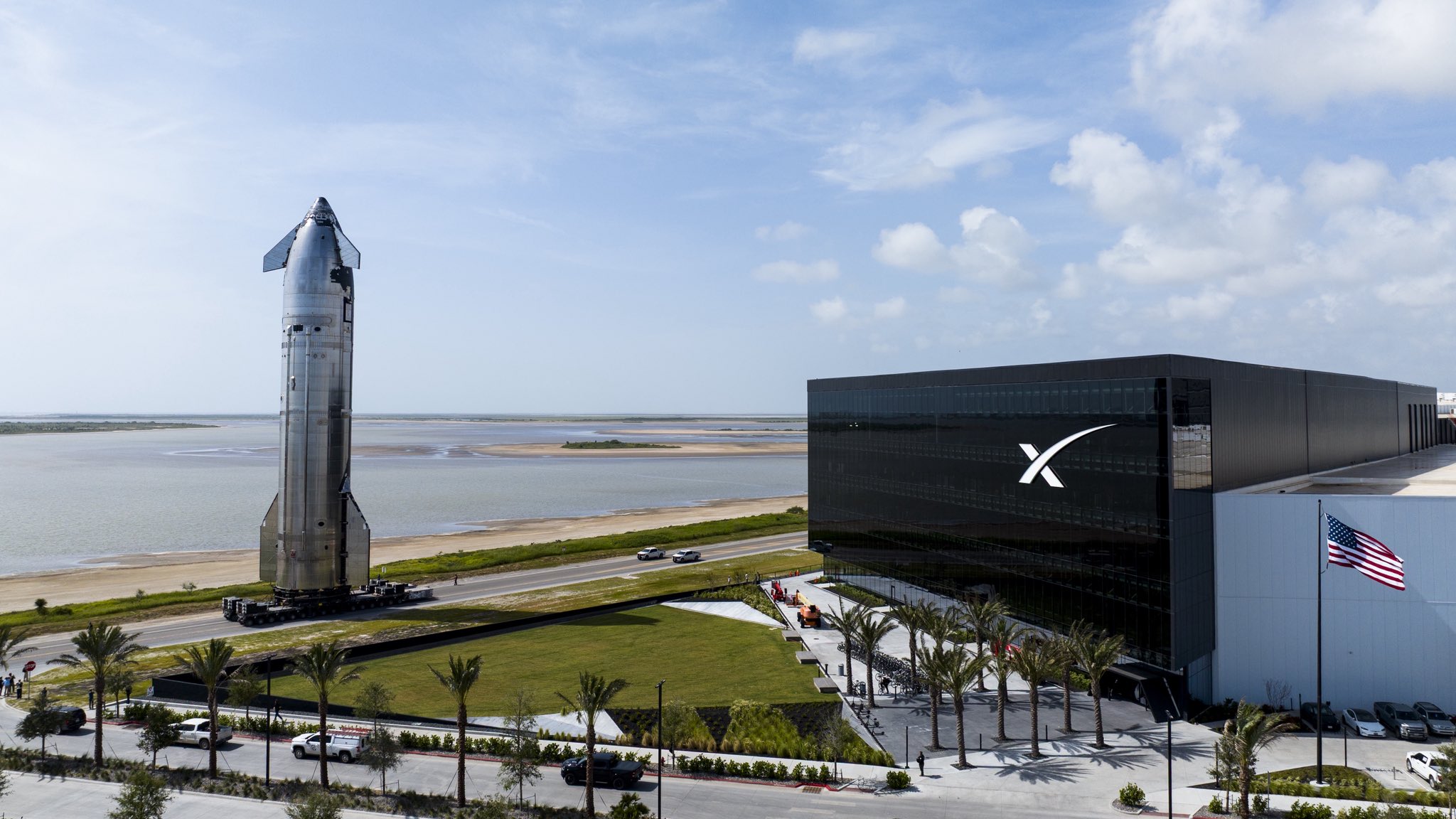

SpaceX
SpaceX goes all-in on steel Starship, scraps expensive carbon fiber BFR tooling
In a wholly unforeseen turn of events, SpaceX has taken the extraordinary step of permanently scrapping both its Port of Los Angeles-based BFR development tent and what seem to be the majority of what it contained, irreparably destroying custom-built tooling meant to support the fabrication of carbon composite BFR spaceships and boosters.
Likely worth anywhere from several to tens of millions of dollars (USD), SpaceX’s advanced BFR production tools were procured from industry-expert Ascent Aerospace sometime in 2017 before being officially delivered to the rocket company’s newly-erected Port of LA tent around April 2018. Situated at the port specifically due to logistical concerns about the high cost of transporting 9m/30ft-diameter objects from SpaceX’s main Hawthorne facilities to a barge for transport east, the company has decided to unequivocally destroy its aerospace-grade composite tooling less than 12 months after accepting delivery. Put simply, this is the best evidence yet that SpaceX – willing or not – has gone all-in on build Starship and Super Heavy out of stainless steel less than six months after CEO Elon Musk began to hint at the program’s utterly radical pivot.

From the very beginning of SpaceX and Elon Musk’s serious pursuit of an entirely reusable launch vehicle capable of transporting dozens of astronauts and passengers to and from Earth and Mars, the plan had been to build the vast majority of the rocket’s booster and spacecraft structures out of advanced carbon fiber composite materials. Above all else, this fundamental architecture was motivated largely by the significant performance gains a rocket could achieve by replacing traditional aluminum tanks and structures with carbon fiber.
For a rocket (and especially an orbital spaceship) meant to somehow make Earth-Mars transport both routine and at least minutely affordable, focusing primarily on the optimization of the mass of cargo delivered relative to the empty weight of the spaceship and booster made (and still does make) a great deal of sense. Assuming that the reusability of a system is roughly constant, the only conceivable way to further lower the cost of price per unit of cargo or passenger ticket would be to increase the usable cargo/passenger capacity for each individual launch, making an extremely light and high-performance rocket the low-hanging fruit target.


The centrality of carbon fiber composites remained with SpaceX’s Sept. 2017 iteration of BFR, downsized by 25% to a diameter of 9m (~30 ft). Around six months later, that commitment to composites was further solidified by the delivery of the first 9m-diameter carbon fiber tooling in March or April 2018. The tooling used to mold and
In the subsequent months of 2018, SpaceX’s BFR and composite R&D team spent tens of thousands of hours building out an ad-hoc advanced composites workshop inside a temporary tent in an industrial area, and ultimately managed to build a number of full-scale carbon fiber segments, including at least one large tank barrel section and the beginnings of a tank dome. In September 2018, that progress was partially revealed alongside the announcement that Japanese billionaire Yasuka Maezawa had purchased the first crewed lunar launch of BFR for several hundred million dollars, set to occur no earlier than 2023.
Two months after indicating that the first BFR “airframe/tank barrel section” would be built out of a “new carbon fiber material”, Musk provided the very first teaser for a “counterintuitive” development that would later be identified as the CEO’s decision to wholly replace BFR’s proposed used of composites with stainless steel and an advanced metallic heat shield. Still more than a little controversial and hard to follow almost half a year later, the feeling at the time was that SpaceX’s eccentric leader had decided to throw away more than 24 months of composite BFR design and development work for an almost entirely unproven alternative approach.
For better or for worse, it appears that SpaceX (or maybe just Musk) has quite literally trashed the most concrete demonstration of a prior commitment to advanced carbon fiber composites, scrapping the vast majority of its composite tooling and perhaps even the prototype BFR segments built in 2018.


It remains to be seen whether the now-permanent decision to pursue a stainless steel design in place of carbon fiber was a very expensive mistake, a stroke of genius, or something in between, However, the undeniably brisk progress made with the BFR’s steel variant in last four or so months bodes well – at a minimum – for Musk’s optimism that this radical change will ultimately result in an operational vehicle far sooner (and presumably cheaper) than the composites route.
Generally speaking, it seems safe to – on the face of it – agree with Musk’s argument that steel should ultimately lend itself far more easily to reusability thanks to its high tolerance for extreme temperatures. Unlike Falcon 9’s aluminum structures (and even the most exotic, advanced carbon fiber composites), certain varieties of stainless steel can weather heating approaching that experienced during orbital reentry with minimal erosion or damage to its mechanical properties. As Musk puts it, the Super Heavy booster’s suborbital trajectory could require almost no heat shielding – and perhaps even paint – at all.
Only time will tell whether the inevitably harsher realities of real-life engineering are so kind. In the meantime, SpaceX is perhaps just hours away from the first attempted static-fire test of a Raptor installed on something approaching flight-hardware, in this case a full-scale Starship hop test prototype.
Check out Teslarati’s Marketplace! We offer Tesla accessories, including for the Tesla Cybertruck and Tesla Model 3.

Elon Musk
SpaceX issues statement on Starship V3 Booster 18 anomaly
The incident unfolded during gas-system pressure testing at the company’s Massey facility in Starbase, Texas.

SpaceX has issued an initial statement about Starship Booster 18’s anomaly early Friday. The incident unfolded during gas-system pressure testing at the company’s Massey facility in Starbase, Texas.
SpaceX’s initial comment
As per SpaceX in a post on its official account on social media platform X, Booster 18 was undergoing gas system pressure tests when the anomaly happened. Despite the nature of the incident, the company emphasized that no propellant was loaded, no engines were installed, and personnel were kept at a safe distance from the booster, resulting in zero injuries.
“Booster 18 suffered an anomaly during gas system pressure testing that we were conducting in advance of structural proof testing. No propellant was on the vehicle, and engines were not yet installed. The teams need time to investigate before we are confident of the cause. No one was injured as we maintain a safe distance for personnel during this type of testing. The site remains clear and we are working plans to safely reenter the site,” SpaceX wrote in its post on X.
Incident and aftermath
Livestream footage from LabPadre showed Booster 18’s lower half crumpling around the liquid oxygen tank area at approximately 4:04 a.m. CT. Subsequent images posted by on-site observers revealed extensive deformation across the booster’s lower structure. Needless to say, spaceflight observers have noted that Booster 18 would likely be a complete loss due to its anomaly.
Booster 18 had rolled out only a day earlier and was one of the first vehicles in the Starship V3 program. The V3 series incorporates structural reinforcements and reliability upgrades intended to prepare Starship for rapid-reuse testing and eventual tower-catch operations. Elon Musk has been optimistic about Starship V3, previously noting on X that the spacecraft might be able to complete initial missions to Mars.
Elon Musk
SpaceX Starship Version 3 booster crumples in early testing
Photos of the incident’s aftermath suggest that Booster 18 will likely be retired.

SpaceX’s new Starship first-stage booster, Booster 18, suffered major damage early Friday during its first round of testing in Starbase, Texas, just one day after rolling out of the factory.
Based on videos of the incident, the lower section of the rocket booster appeared to crumple during a pressurization test. Photos of the incident’s aftermath suggest that Booster 18 will likely be retired.
Booster test failure
SpaceX began structural and propellant-system verification tests on Booster 18 Thursday night at the Massey’s Test Site, only a few miles from Starbase’s production facilities, as noted in an Ars Technica report. At 4:04 a.m. CT on Friday, a livestream from LabPadre Space captured the booster’s lower half experiencing a sudden destructive event around its liquid oxygen tank section. Post-incident images, shared on X by @StarshipGazer, showed notable deformation in the booster’s lower structure.
Neither SpaceX nor Elon Musk had commented as of Friday morning, but the vehicle’s condition suggests it is likely a complete loss. This is quite unfortunate, as Booster 18 is already part of the Starship V3 program, which includes design fixes and upgrades intended to improve reliability. While SpaceX maintains a rather rapid Starship production line in Starbase, Booster 18 was generally expected to validate the improvements implemented in the V3 program.
Tight deadlines
SpaceX needs Starship boosters and upper stages to begin demonstrating rapid reuse, tower catches, and early operational Starlink missions over the next two years. More critically, NASA’s Artemis program depends on an on-orbit refueling test in the second half of 2026, a requirement for the vehicle’s expected crewed lunar landing around 2028.
While SpaceX is known for diagnosing failures quickly and returning to testing at unmatched speed, losing the newest-generation booster at the very start of its campaign highlights the immense challenge involved in scaling Starship into a reliable, high-cadence launch system. SpaceX, however, is known for getting things done quickly, so it would not be a surprise if the company manages to figure out what happened to Booster 18 in the near future.
Elon Musk
SpaceX’s next project will produce Starships at a level that sounds impossible
1,000 rockets per year is an insane number, especially considering Starship’s sheer size.

Elon Musk has revealed bold plans for SpaceX’s newest Starbase facility in Texas, predicting it will become a birthplace for “so many spaceships.” The upcoming “Gigabay,” a massive $250 million production hub in Starbase, Texas, is designed to manufacture up to 1,000 Starship rockets per year.
That’s an insane number of rockets for a single facility, especially considering Starship’s sheer size.
One of the world’s largest industrial structures
SpaceX’s Gigabay is expected to stand roughly 380 feet tall and enclose 46.5 million cubic feet of interior space, making it one of the largest industrial structures to date. The facility will feature 24 dedicated work cells for assembling and refurbishing Starship and Super Heavy vehicles, complete with heavy-duty cranes capable of lifting up to 400 U.S. tons, as noted in a Times of India report.
Construction crews have already placed four tower cranes on-site, with completion targeted for December 2026. Once operational, the Gigabay is expected to boost SpaceX’s launch cadence dramatically, as it would be able to build up to 1,000 reusable Starships per year, as noted in a report from the Dallas Express. Musk stated that the Gigabay will be “one of the biggest structures in the world” and hinted that it represents a major leap in Starbase’s evolution from test site to full-scale production hub.
A key step toward Mars and beyond
Starship is SpaceX’s heavy-lift rocket system, and it remains a key part of Elon Musk’s vision of a multiplanetary future. The vehicle can carry 100–150 tonnes to low Earth orbit and up to 250 tonnes in expendable mode. With several successful flights to date, including a perfect 11th test flight, the Starship program continues to refine its reusable launch system ahead of crewed lunar missions under NASA’s Artemis initiative.
Starship is unlike any other spacecraft that has been produced in the past. As per Elon Musk, Starship is a “planet-colonizer” class rocket, as the magnitude of such a task “makes other space transport task trivial.” Considering Starship’s capabilities, it could indeed become the spacecraft that makes a Moon or Mars base feasible.








